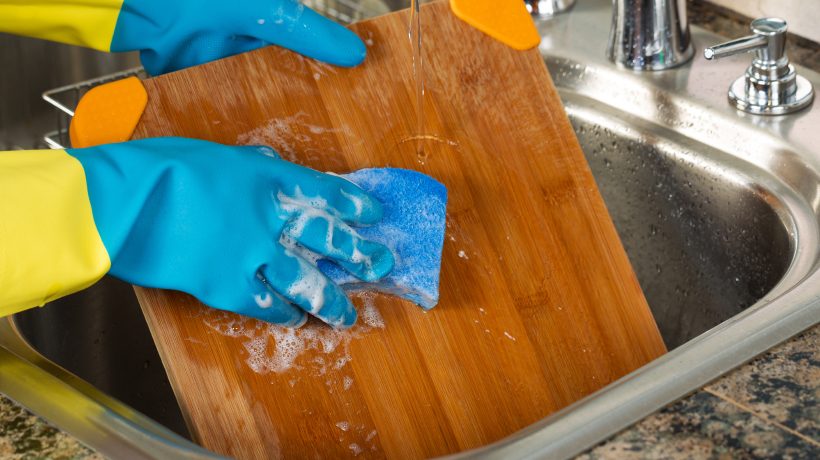Top Tip
For quick, effortless cleaning place your plastic cutting board in the dishwasher – this way no extra washing or scrubbing will be necessary.
Key Steps:
- It’s important to use different chopping boards for different types of food; this will prevent cross contamination and save you from constantly having to wash your chopping board when preparing meals.
- Hot water and a dishwashing liquid, like Lux Sunlight Lemon, are essentials for everyday chopping board cleaning. Just follow the directions on the label for the best results.
- On a weekly basis, give your chopping boards a thorough clean with a sanitising solution.
Keeping your chopping boards clean is an essential part of kitchen hygiene. After all, the chopping board is where you do all your food preparation – from dicing garlic to slicing raw meat. There’s a significant risk of spreading harmful bacteria, like salmonella and e-coli. The good news is that a regular cleansing routine can prevent food contamination and ensure your chopping board – and your kitchen – stays as germ-free as possible.
Cleaning Chopping Boards
When cleaning your chopping boards, bear in mind:
- The best method for keeping chopping boards clean is to scrub them in the washing up bowl, using very hot water and a dishwashing liquid like Lux Sunlight Lemon
- Rinse and dry your chopping board with paper towels, as dishcloths often contain germs from hands and other food equipment and may contaminate a clean chopping board.
- Running your cutting boards through a dishwasher with a reliable detergent will get you the best results; a dishwasher should not be used for wooden boards as they can warp in high temperatures.
Sanitising Chopping Boards
To practice a good level of hygiene in the kitchen, sanitise your chopping board every week, or more often if necessary. Here’s how:
- The most effective method is to soak cutting boards in a solution of 1 tablespoon of chlorine-based bleach to a gallon of water.
- Leave for half an hour, then rinse thoroughly, and air-dry upright on a rack.
- Alternatively, use common household ingredients with anti-bacterial properties, like white vinegar, to wipe over the cutting surface before leaving to dry.
Tip: If you notice your chopping boards are starting to smell of onions or raw fish, dip a paper towel in pure lemon juice, or rub half a lemon over the surface and it will smell citrus-fresh in no time!
Preventing Food Contamination
No one wants an upset stomach from contaminated food. Follow this advice to avoid potential problems:
- Buy hard acrylic or rubber boards, as they are generally considered the most hygienic choice (these are commonly used in restaurant kitchens).
- Wooden boards should be kept as clean and as sanitised as possible.
- Consider using beeswax or mineral oil to treat the surface of wood cutting boards every few months, to help form a natural seal against food contamination.
- It’s safest to use different boards for different types of food. You should have at least two: one for raw meat and fish and one for vegetables, bread and anything that can be eaten safely uncooked.
- Purchase colour-coded sets of cutting boards, or label your boards yourself, so that you remember which board is which.
- Throw away any chopping boards that are really cracked, scratched and or visibly dirty. Like all kitchen equipment, cutting boards have a shelf-life and it’s vital that you get rid of old boards to maintain a safe, healthy kitchen.
All rights reserved to the initial publisher for Cleanipedia
Collected and published by Arms &McGregor International Realty® editorial team. Get in touch with us at [email protected]

